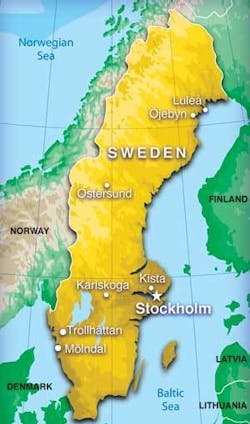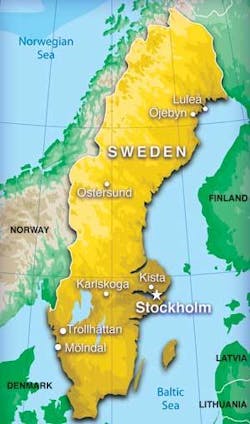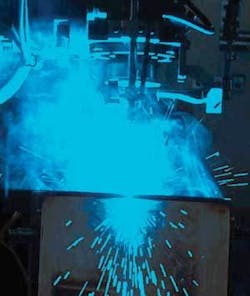Modern Vikings conquer with photons
Alexander F. H. Kaplan
The first three high-power lasers in Sweden were installed in 1979, almost simultaneously, at FOA, Luleå University of Technology, and Permascand (these pioneers are still debating which one of them ordered the laser first, which one switched on first, etc.). Since then a rapid development has led to more than 500 CO2 lasers and 100 Nd:YAG lasers being installed somewhere in the wild, silent forests of Sweden.
One of the driving forces for laser implementation has been the Volvo Car Corporation, which initiated the Swedish high-power laser lab located at Luleå University of Technology (situated merely 150 km south of the Arctic Circle). Through their cooperative research, laser cutting was introduced to Volvo in the early 1980s. Under the foresighted encouragement of Johnny K. Larsson (a well-known advocate for laser processing in the auto industry), Volvo was among the first to introduce CO2 laser roof welding into on-line production. Since then Volvo has implemented Nd:YAG lasers in a series of welding applications and, last year, into laser brazing.
In 2003 Scania, the truck manufacturer, ramped up laser welding of rear axles with a 12kW CO2 laser in its subsidiary Ferruform AB (Luleå). The result was a joint patent with Luleå TU on a specially developed laser system, including process monitoring.
In 2005 another milestone was reached in Luleå; the first hybrid welding application in production by a job shop. Duroc Rail AB, welds heavy, long high-strength steel plates with a 20kW CO2 laser combined with MAG. Feasibility studies (including this one) on hybrid welding have been performed at Luleå TU for many industrial partners, for example, laser welding of a truck cross member for Ferruform/Scania (see Figure 1), or demonstrating the excellent mechanical properties of Ultra High Strength Steel (up to 1400 MPa) for Swedish Steel AB (SSAB). In response to this activity the arc welding equipment and wire supplier ESAB opened a hybrid laser welding lab in 2005 for its customers and for process development, in cooperation with Permanova Lasersystem AB (Mölndal), a laser processing head and component supplier.
Other welding applications of interest include a joining process (somewhere between laser soldering and laser spot welding) at Ericsson Microelectronics (Kista), laser welding of specially press-hardened profiles at the automotive supplier Accra Teknik AB (Öjebyn), tailored blank laser welding at Pemectra Lasertech AB (Trollhättan), assisted by on-line process monitoring and automated post inspection, and laser welding of heat exchangers at Alfa Laval Lund AB.
Many more applications are in the feasibility and development phase (for example at Volvo Aero on aircraft and aerospace engine parts), generating new ideas about the potential for new applications in production in the short and mid-term. It is interesting to note the many laser welding job shops emerging, including Lasertech LSH AB (Karlskoga) (equipped with nine high-power lasers, for military high precision applications); Nordic Laser (Mölndal), equipped with a 2kW DPSS laser and with a medium power diode laser; CEPA; Gnosjö Lasercentrum; and LaserNova AB (Östersund), mainly using pulsed Nd:YAG lasers for microwelding for medical and biotech products.
Nevertheless, the majority of applications can be found in laser cutting. Besides the numerous cutting job shops (for example, Weland with about 20 lasers installed), an increasing number of 3D-applications like tube and profile cutting are apparent, including the cutting of large roller bearing cages at SKF and of turbine blade components at Siemens Industrial Turbomachinery AB. Thanks to the lower thickness of high strength steel products, traditional thermal cutting methods are being replaced by laser cutting.
Duroc AB, a leader in laser surface treatment, is also performing laser welding and 6kW diode laser hardening of forming tools (mainly deep drawing tools for the automotive industry) and a series of laser cladding applications, for example for power plants. Laser cladding of railway wheels at Duroc Rail AB was replaced by a more economical non-laser technique, while laser cladding of piston rings for large two stroke ship marine engines is still under investigation. Laser casting, a new process developed at Luleå TU, has recently been investigated for industrial applications. However, the number of powder assisted laser surface treatments or rapid prototyping applications is still very limited in Sweden, despite a strong machinery and component industry. The same is true for micromachining which is limited to only rather few applications at the moment.
The industrial laser sector is supported by the Swedish industrial laser association (established in 1990, through the initiative of Claes Magnusson, then professor at Luleå TU, and others) with about 55 member companies, disseminating knowledge through courses, company visits, seminars, and a Swedish industrial laser journal (three issues per year, since 1995). Important support for industrial end users is provided by the system suppliers like Permanova (components), ESAB (hybrid welding), or TRUMPF (service subsidiary on laser systems) or by the gas suppliers AGA and Air Liquide (service subsidiary), as well as by the robot manufacturers Motoman and ABB.
As you can see the industrial application of lasers is thriving up here in the north.
Alexander Kaplan is professor of Manufacturing/Laser Materials Processing at Luleå University of Technology, Sweden.


